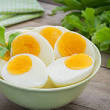Eggs: The Best Emulsifier?
- Nelson Quarshie Attipoe
- Jun 10, 2024
- 4 min read
Updated: Nov 6, 2024
Introduction
In the realm of culinary arts, emulsions play a crucial role in creating a wide array of delectable dishes, from velvety sauces to light and airy mousses. At the heart of many of these culinary marvels lies a humble yet incredibly versatile ingredient: the egg. Often referred to as nature's own emulsifier, eggs possess unique properties that make them indispensable in the kitchen, particularly when it comes to emulsifying liquids that would otherwise separate.

An emulsion refers to a mixture of two immiscible liquids, such as oil and water, which consists of one liquid dispersed in the other in the form of tiny droplets. This dispersion is achieved through the action of an emulsifying agent, which helps to stabilize the mixture by reducing the interfacial tension between the two liquids (Damodaran, 2017). Eggs, with their unique composition of proteins, lecithin, and other compounds, function as natural emulsifiers, allowing for the creation of stable and homogeneous mixtures that would otherwise separate into distinct layers.
Egg Composition and Emulsifying Properties
The emulsifying properties of eggs can be attributed to their remarkable composition. One of the primary components responsible for their emulsifying abilities is lecithin, a naturally occurring phospholipid found in the egg yolk (Martini & Herrera, 2018). Lecithin molecules have a hydrophilic (water-loving) head and a hydrophobic (water-repelling) tail, making them excellent surfactants that can function as emulsifiers by aligning themselves at the interface between oil and water.
In addition to lecithin, egg yolks also contain a variety of proteins, including lipoproteins and globulins, which contribute to the emulsifying process. These proteins possess both hydrophilic and hydrophobic regions, allowing them to interact with both water and oil molecules, facilitating the formation and stabilization of emulsions (Martini & Herrera, 2018).
Furthermore, the physical structure of egg proteins plays a crucial role in their emulsifying capabilities. When beaten or whipped, the egg proteins undergo structural changes that expose their hydrophobic regions, enabling them to interact more effectively with oil molecules and form stable emulsions (Laca et al., 2010).
Applications in the Culinary World
The emulsifying properties of eggs have made them indispensable in a wide range of culinary applications, from savoury dishes to sweet treats. They can be used in various foods and food products and some of their wonder works can be seen below.
1. Mayonnaise and Salad Dressings:
One of the most well-known applications of eggs as emulsifiers is in the preparation of mayonnaise and salad dressings. In these preparations, egg yolks act as the primary emulsifying agent, allowing for the stable incorporation of oil into a water-based mixture. The lecithin and proteins present in the egg yolks help to create a thick, creamy emulsion that binds the oil and water together, resulting in a smooth and velvety texture.
2. Baked Goods:
Eggs play a crucial role in the preparation of various baked goods, such as cakes, cookies, and breads. In these applications, eggs not only contribute to the structure and texture of the baked goods but also act as emulsifiers, helping to incorporate and distribute fat evenly throughout the batter or dough. This emulsification process results in a more uniform and tender crumb, as well as improved moisture retention and shelf life.
3. Custards and Creams:
Custards, crèmes, and other egg-based desserts rely heavily on the emulsifying properties of eggs. In these preparations, the egg yolks help to create a smooth and velvety texture by emulsifying the milk or cream with any added fats or oils. The resulting emulsion not only enhances the overall mouthfeel but also contributes to the richness and creaminess of the dessert.
4. Sauces and Gravies:
Eggs are often used as emulsifiers in the preparation of various sauces and gravies, such as hollandaise, béarnaise, and mayonnaise-based sauces. The egg yolks help to create a stable emulsion between the fat (butter or oil) and the acidic liquid (lemon juice or vinegar), resulting in a smooth, velvety texture that coats and enhances the flavours of the dish.
Challenges and Considerations
While eggs are undoubtedly excellent emulsifiers, there are certain challenges and considerations to keep in mind when working with them in the kitchen.
1. Temperature Sensitivity:
Egg proteins are sensitive to heat, and overheating can cause them to denature and lose their emulsifying properties. This is particularly important when preparing custards, sauces, and other egg-based dishes, where precise temperature control is crucial to maintain a stable emulsion.
2. Allergies and Dietary Restrictions:
For individuals with egg allergies or dietary restrictions, such as veganism or certain religious practices, the use of eggs as emulsifiers may not be an option. In such cases, alternative emulsifiers derived from plant-based sources, such as lecithin from soybeans or sunflowers, can be used as substitutes.
3. Food Safety:
Eggs that are undercooked or raw eggs can pose a risk of foodborne illnesses, such as salmonella. It is therefore essential to follow proper food handling and cooking guidelines to ensure the safety of egg-based dishes, especially those that contain raw or partially cooked eggs.
Conclusion
Eggs, with their unique composition and properties, have proven themselves to be one of the most versatile and effective emulsifiers in the culinary world. From creating rich and creamy sauces to producing light and airy baked goods, eggs play a vital role in bringing together ingredients that would otherwise separate. Their natural emulsifying abilities, derived from the lecithin and proteins present in the egg yolk, have made them an essential component in countless recipes across various culinary traditions.
While alternative emulsifiers exist, the ease of use, accessibility, and familiarity of eggs make them a preferred choice for many home cooks and professional chefs alike. However, it is crucial to consider factors such as temperature sensitivity, dietary restrictions, and food safety when working with eggs as emulsifiers.
As culinary techniques continue to evolve, the exploration of eggs' emulsifying properties and their applications in the kitchen will undoubtedly continue, further solidifying their status as nature's own emulsifier and a culinary treasure.
References
Damodaran, S. (2017). Food Proteins and Their Applications (2nd ed.). Springer.
Laca, A., Saenz, M. C., Paredes, B., & Diaz, M. (2010). Thermal denaturation of Egg Yolk Proteins: Cystatin, Vitellenin and Lipoprotein Complex Behaviour. Journal of Food Science, 75(7), C466-C476. https://doi.org/10.1111/j.1750-3841.2010.01719.x
Martini, S., & Herrera, M. L. (2018). Nutritional Value and Egg Functionality. In M. L. Herrera & E. Güemes-Vera (Eds.), Eggs as Functional Foods and Nutraceuticals for Human Health (pp. 1-19). The Royal Society of Chemistry. https://doi.org/10.1039/9781788013239-00001
Did you find this post useful?
YES
NO


Kommentare